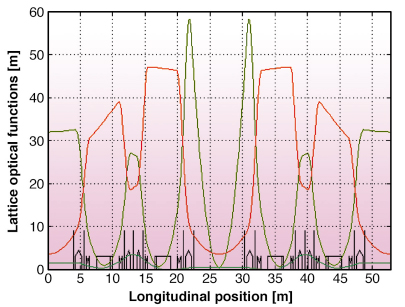- Home
- Users & Science
- Scientific Documentation
- ESRF Highlights
- ESRF Highlights 2006
- The X-ray Source
- Storage ring magnet lattice
Storage ring magnet lattice
The installation of canted undulators in some of the straight sections of the ESRF storage ring is envisaged in the future. In order to minimise the reduction in flux / brilliance induced by the splitting of the straight sections and the chicane magnet setup, the possibility of increasing the available space for insertion devices in straight sections beyond the 5 m currently available has been investigated.
The ESRF storage ring’s double bend achromat lattice type was designed with quadrupole triplets in the straight sections to provide maximum flexibility and allow the possibility of setting a wide range of b values in the straight sections. This flexibility has never been used and replacing the quadrupole triplets by doublets is attractive with regards to free space. Indeed the removal of the last quadrupole adjacent to the ID allows an increase in the ID length from 5 to 6 m. In 2006, a new current setting for all quadrupoles and sextupoles of the lattice that do not power the QD1 and QD8 family (located on both sides of the undulators) was defined. This was tested and implemented in User Service Mode in October 2006. Minor changes in beam parameters were induced by this change of lattice functions. In order to anticipate a longer-term evolution of the lattice where the available space for IDs could be further increased to 7 m by shortening the long quadrupoles of the doublets, the vertical ß in the straight section has been increased from 2.5 m to 3.5 m, thus leading to a reduction of the vertical tune by 2 integers. The lattice functions are shown in Figure 156.
 |
|
Fig. 156: New lattice functions allowing the implementation of 6 m long IDs. |
As of December 2006, the lifetime in uniform filling mode is about 55 h compared to 75 h for the previous lattice. A further optimisation of the non linear lattice is required and this will be done in 2007. This should restore the original lifetime.
The new lattice has a nominal horizontal emittance of 3.7 nm and an energy spread of 0.11 % (against 3.8 nm and 0.11% for the one in used so far). Table 6 gives the beta functions, dispersion and beam size in both horizontal and vertical planes for the new lattice. There are small variations such as a 20% increase of the vertical beam size and a similar decrease in divergence. There is also a reduction of the horizontal source size in both high and low beta ID source points by 6 and 11% respectively.
 |
|
Table 6 : Beta functions, dispersion, rms beam size and divergence for the various source points of the ring operated with the new lattice settings. |



